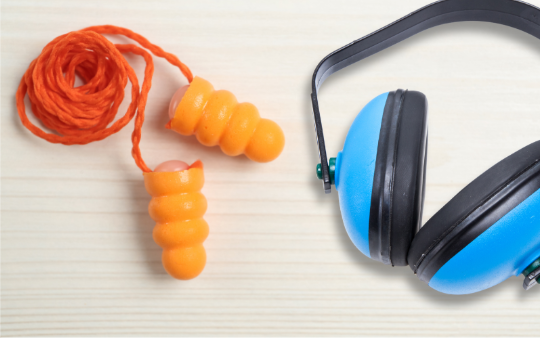Exposure to excessive noise can lead to long-term hearing damage, making ear protection a crucial aspect of workplace safety. From industrial sites to recreational settings, safeguarding hearing is essential for preventing noise-induced hearing loss. Selecting the appropriate hearing protection requires an understanding of different options, their effectiveness, and the environments in which they are best suited. This guide explores key factors to consider when choosing ear protection, ensuring compliance with PPE and safety equipment standards while maintaining comfort and functionality.
Types of Ear Protection
Selecting the right type of hearing protection depends on the level of noise exposure and the specific demands of the environment. Two primary types include earplugs and earmuffs, each offering distinct benefits.
Earplugs are compact, lightweight, and designed to fit directly into the ear canal. They provide an effective barrier against noise while remaining discreet and comfortable for prolonged use. Disposable foam earplugs are ideal for one-time use, while reusable silicone or custom-moulded earplugs offer a more durable solution. These options are suitable for environments where high noise levels persist for extended periods, such as manufacturing plants and construction sites.
Earmuffs, on the other hand, provide full coverage over the ears and rely on a cushioned seal to reduce noise levels. They are particularly beneficial in environments where intermittent noise exposure occurs, as they can be easily removed and reapplied. Some models include electronic features that allow communication while reducing harmful noise levels. This makes them suitable for work settings where verbal interaction is necessary, such as aviation and emergency response operations.
Selecting between earplugs and earmuffs depends on factors such as the intensity of noise exposure, comfort requirements, and the need for additional features like communication compatibility.
Key Considerations for Selecting Hearing Protection
Several factors influence the choice of ear protection, ensuring effectiveness while maintaining comfort and usability.
Comfort and Fit
Ensuring that ear protection fits correctly enhances its effectiveness and wearability. Poorly fitted earplugs or earmuffs may not provide adequate noise reduction and can lead to discomfort over time. Custom-moulded earplugs offer a precise fit, making them ideal for long-term use. Earmuffs with adjustable headbands and cushioned padding enhance comfort while ensuring a secure seal against external noise.
Noise Reduction Rating (NRR)
The noise reduction rating (NRR) measures the effectiveness of hearing protection in reducing noise exposure. A higher NRR value indicates greater noise reduction. It is important to select a product with an appropriate NRR based on the workplace environment. For example, heavy machinery operations require ear protection with a high NRR, while office workers exposed to occasional background noise may need minimal protection.
Compatibility with Other PPE and Safety Equipment
Certain work environments require additional PPE and safety equipment, such as helmets, goggles, or respiratory masks. Ear protection should not interfere with these items. Low-profile earmuffs are designed to accommodate headgear, while specialised earplugs fit comfortably beneath protective helmets. Ensuring compatibility between different pieces of PPE improves overall safety and functionality.
Durability and Maintenance
The longevity of hearing protection depends on material quality and maintenance. Disposable earplugs require frequent replacement to maintain effectiveness, while reusable options need regular cleaning. Earmuffs should be checked for wear and tear, particularly in the headband and ear cushions, to ensure continued performance. Choosing durable materials extends the lifespan of protective equipment while maintaining hygiene and safety standards.
Situations Requiring Hearing Protection
Certain work environments and activities necessitate the use of hearing protection to prevent long-term damage.
Industrial and Construction Settings
Heavy machinery, power tools, and constant industrial noise pose significant risks to hearing health. Factories, construction sites, and metalworking facilities generate noise levels that exceed safe thresholds. Workers in these environments require high-quality ear protection to mitigate exposure and comply with workplace safety regulations.
Aviation and Transportation
Aircraft engines, railway operations, and vehicle maintenance involve exposure to high-decibel noise. Pilots, ground crew members, and mechanics benefit from specialised hearing protection that reduces harmful noise while allowing communication. Earmuffs with active noise-cancelling technology are particularly effective in these industries.
Recreational and Sporting Activities
Loud environments are not limited to workplaces. Shooting ranges, motor racing, and live concerts expose individuals to harmful noise. Ear protection plays a vital role in preventing temporary and permanent hearing loss. High-fidelity earplugs designed for musicians or electronic earmuffs for shooters help maintain auditory safety without compromising situational awareness.
Ensuring Compliance with Safety Regulations
Regulatory bodies establish noise exposure limits and PPE requirements to protect workers from hearing damage. Employers are responsible for providing appropriate ear protection and ensuring compliance with health and safety regulations. Regular noise assessments help determine suitable protection levels while training employees on proper use enhances effectiveness.
Workplaces should establish protocols for selecting, maintaining, and replacing hearing protection. Conducting regular inspections ensures that PPE and safety equipment remain in optimal condition. Compliance with regulatory standards not only safeguards workers but also prevents legal and financial consequences for organisations.
Protecting hearing is a fundamental aspect of workplace and recreational safety. Understanding the different types of ear protection, key selection factors, and the importance of compliance with safety regulations ensures effective noise reduction and long-term hearing health. In an industrial setting, transportation sector, or recreational activity, selecting the right hearing protection minimises risks while maintaining comfort and usability.
For expert guidance on selecting the best ear protection for your needs, contact SafetySam today. Our team is ready to assist in finding the most effective hearing protection solutions tailored to your environment.

